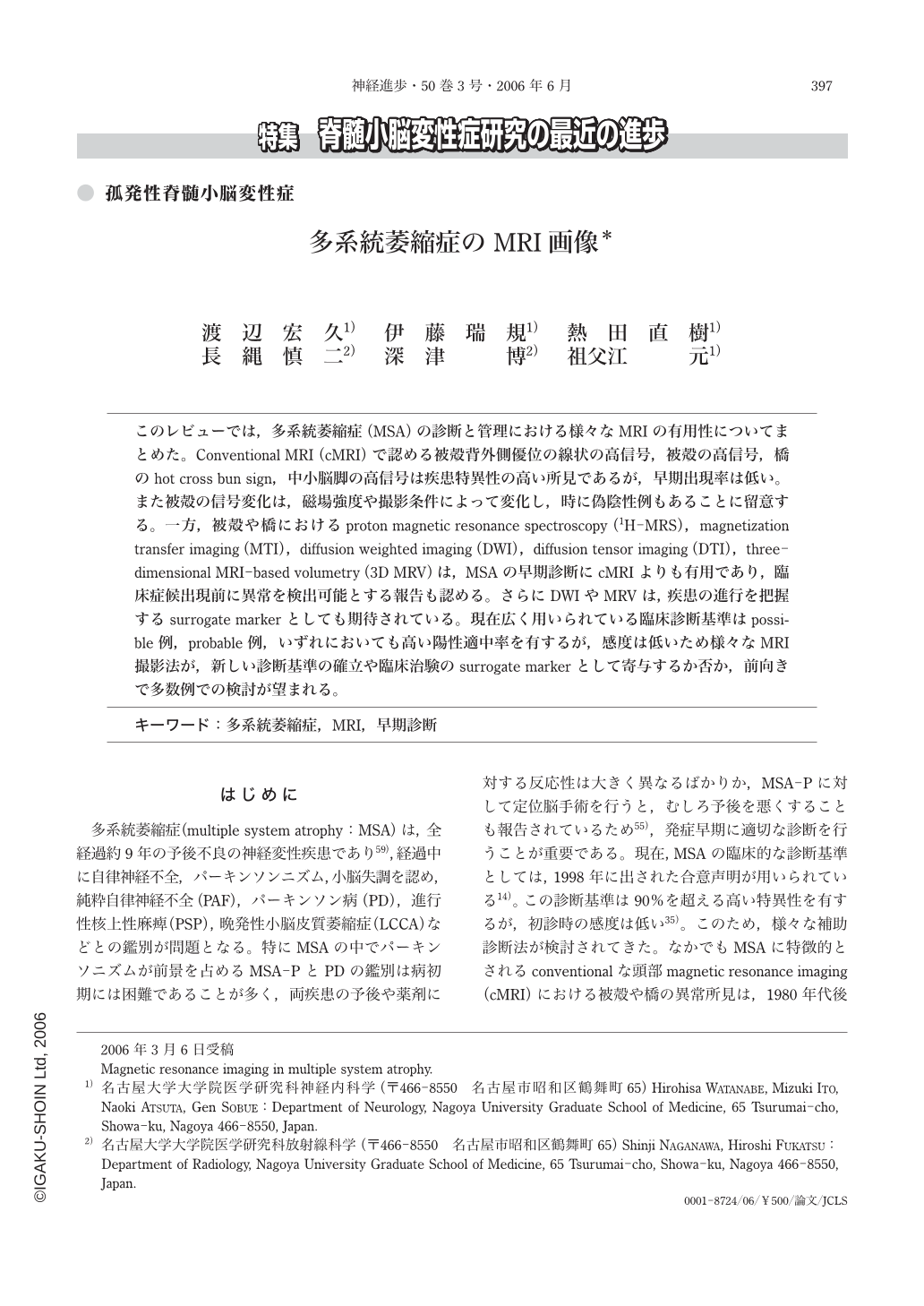Japanese
English
- 有料閲覧
- Abstract 文献概要
- 1ページ目 Look Inside
- 参考文献 Reference
このレビューでは,多系統萎縮症(MSA)の診断と管理における様々なMRIの有用性についてまとめた。Conventional MRI(cMRI)で認める被殻背外側優位の線状の高信号,被殻の高信号,橋のhot cross bun sign,中小脳脚の高信号は疾患特異性の高い所見であるが,早期出現率は低い。また被殻の信号変化は,磁場強度や撮影条件によって変化し,時に偽陰性例もあることに留意する。一方,被殻や橋におけるproton magnetic resonance spectroscopy(1H-MRS),magnetization transfer imaging(MTI),diffusion weighted imaging(DWI),diffusion tensor imaging(DTI),three-dimensional MRI-based volumetry(3D MRV)は,MSAの早期診断にcMRIよりも有用であり,臨床症候出現前に異常を検出可能とする報告も認める。さらにDWIやMRVは,疾患の進行を把握するsurrogate markerとしても期待されている。現在広く用いられている臨床診断基準はpossible例,probable例,いずれにおいても高い陽性適中率を有するが,感度は低いため様々なMRI撮影法が,新しい診断基準の確立や臨床治験のsurrogate markerとして寄与するか否か,前向きで多数例での検討が望まれる。
Multiple system atrophy(MSA)is a sporadic neurodegenerative disease that is still difficult to clinical diagnose. In particular, discriminating clearly between MSA-P(predominantly parkinsonian motor subtype)and Parkinson's disease has long been a diagnostic problem from both therapeutic and prognostic viewpoints. This review discusses the utility of the different MR techniques in the diagnosis and management of MSA. Conventional MRI are widely used and can show characteristic signal abnormalities such as putaminal hyperintensity, hyperintense putaminal rim, putaminal hypointensity, hot cross bun sign in the pontine base, and hyperintensity in the middle cerebellar peduncles strengthening a diagnosis of MSA. However, the diagnostic utility of these signal abnormalities in early MSA remains restricted. In addition, it should be considered that different magnetic field strengths and sequences could be influenced on the findings resulting false negative. On the other hand, proton magnetic resonance spectroscopy(1H-MRS), magnetization transfer imaging(MTI), diffusion weighted imaging(DWI), diffsion tensor imaging(DTI)and three-dimensional MRI-based volumetry(3D MRV)in the pontine base and putamen will be informative in the early diagnosis of MSA prior to conventional MRI changes and even before any clinical manifestation of symptoms. Moreover, DWI and MRV are expected to have potential as surrogate markers of disease progression. Although consensus criteria showed excellent positive predictive values for both possible and probable MSA, sensitivity for probable MSA, particularly early in the course of illness, was poor. Further prospective and large studies including earlier disease stages will be needed to clarify whether these novel MR techniques will aid in the future sets of diagnostic criteria and therapeutic trials.

Copyright © 2006, Igaku-Shoin Ltd. All rights reserved.


